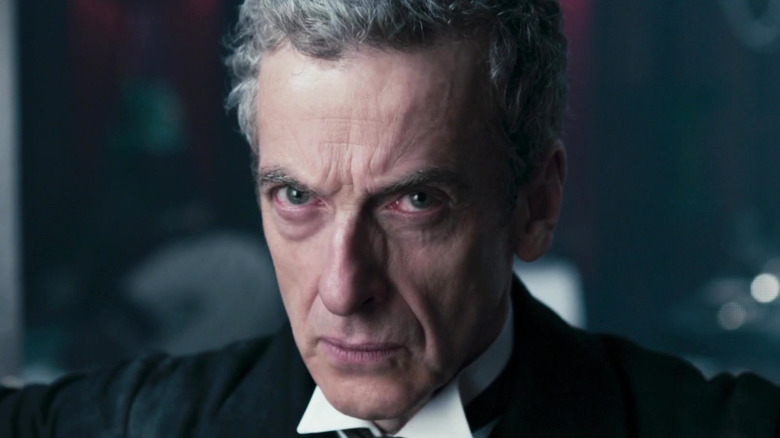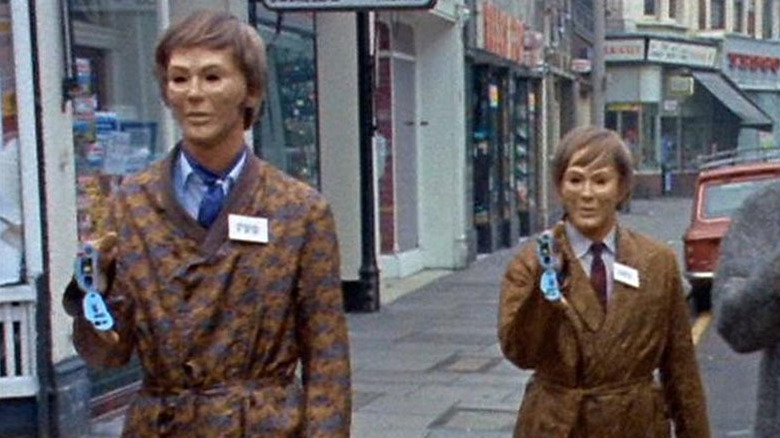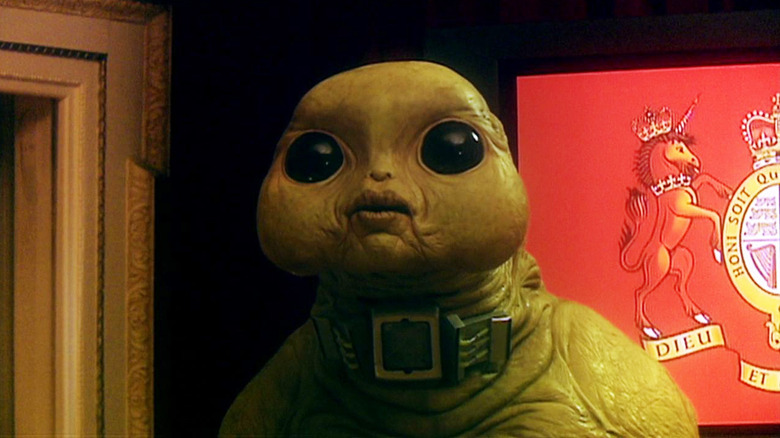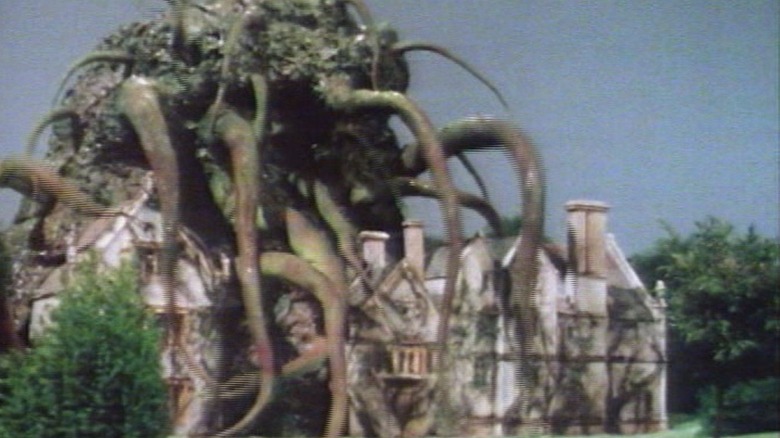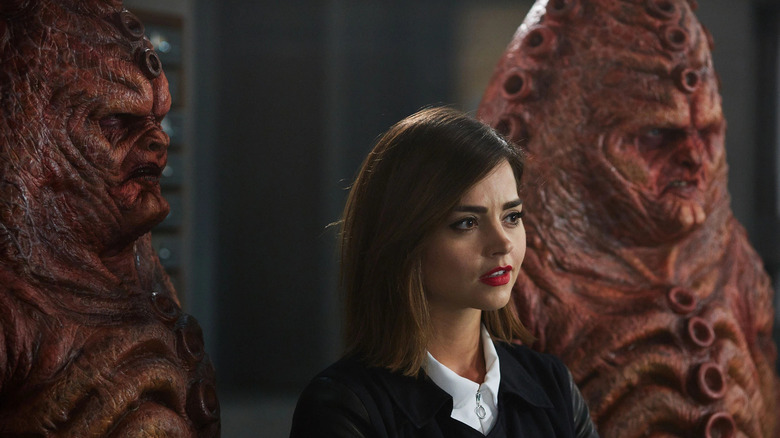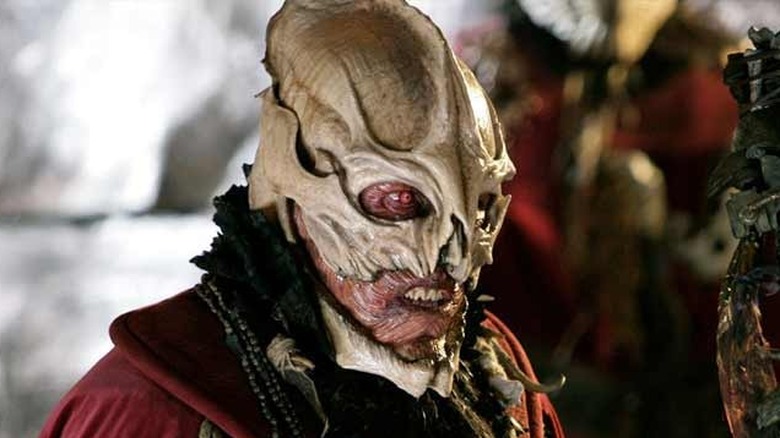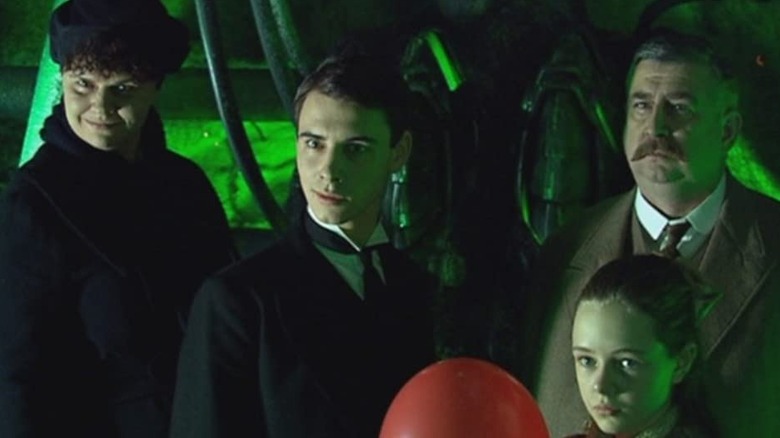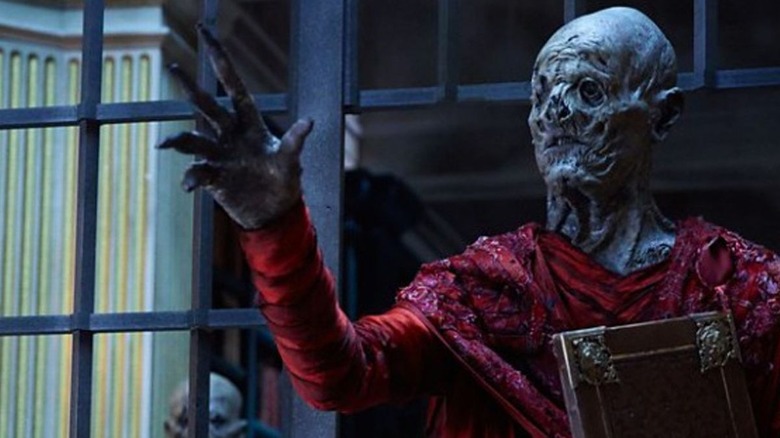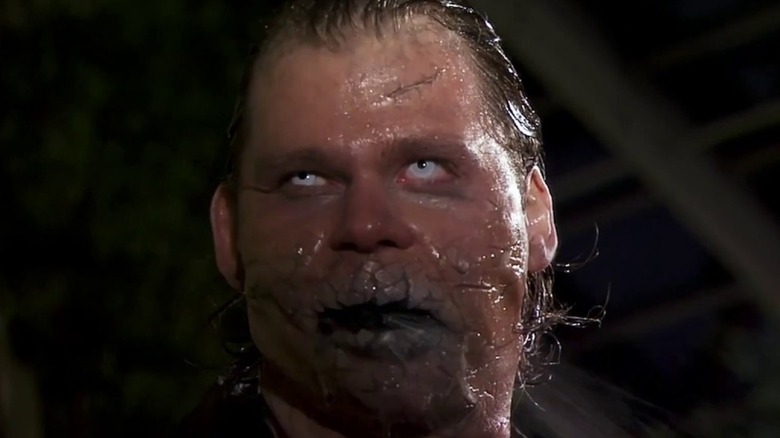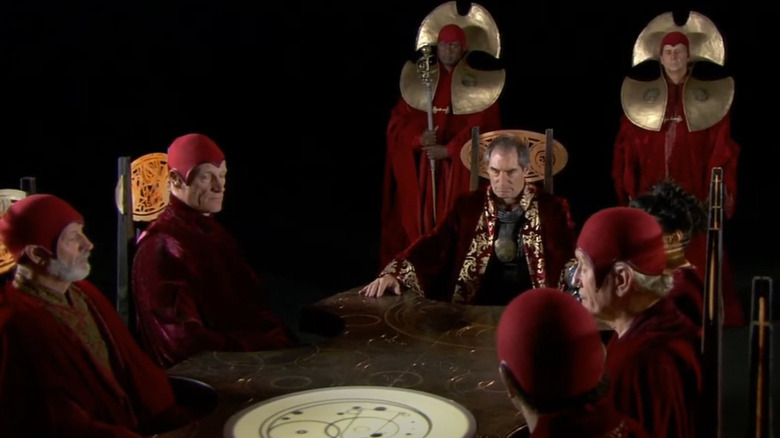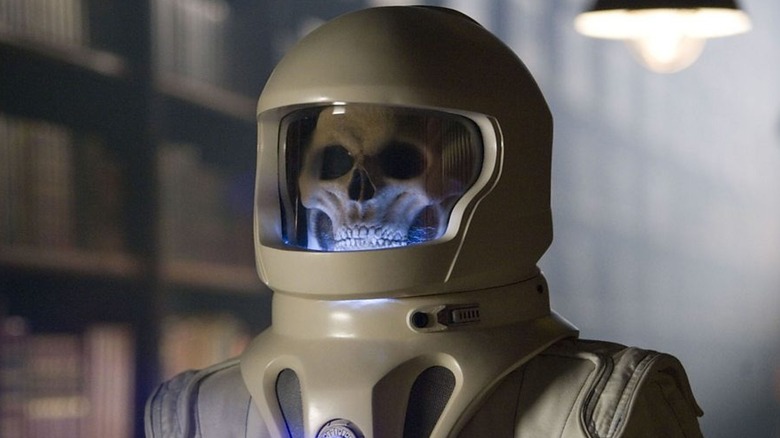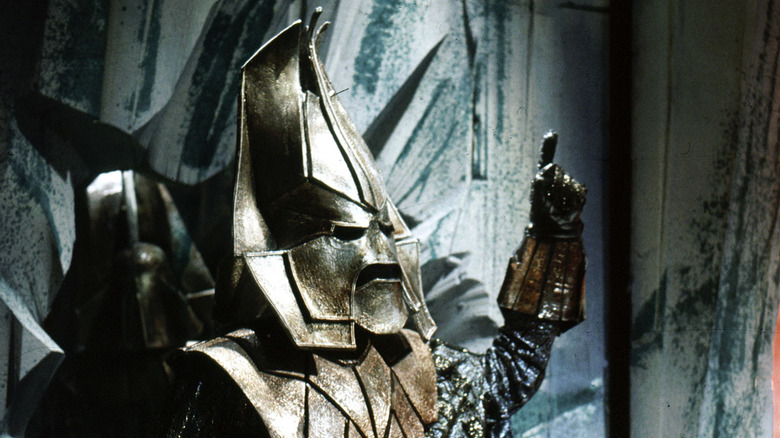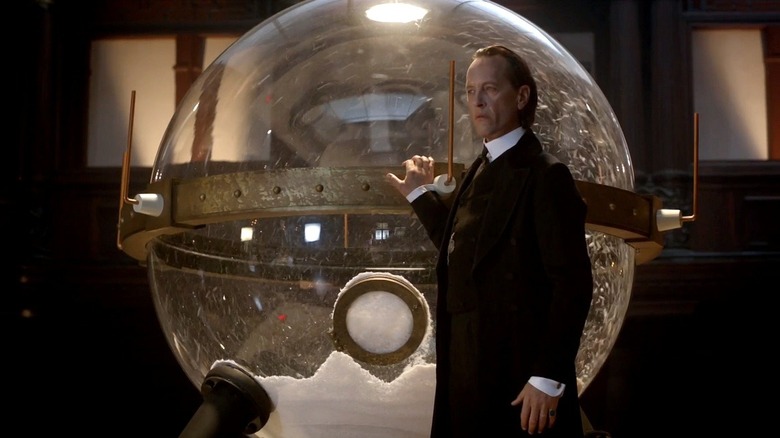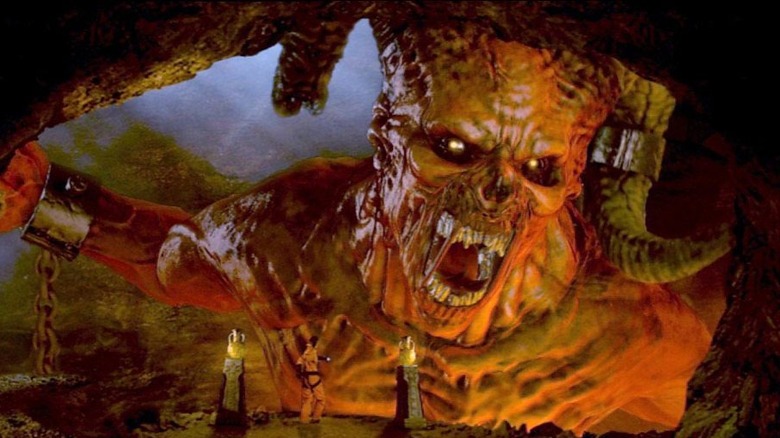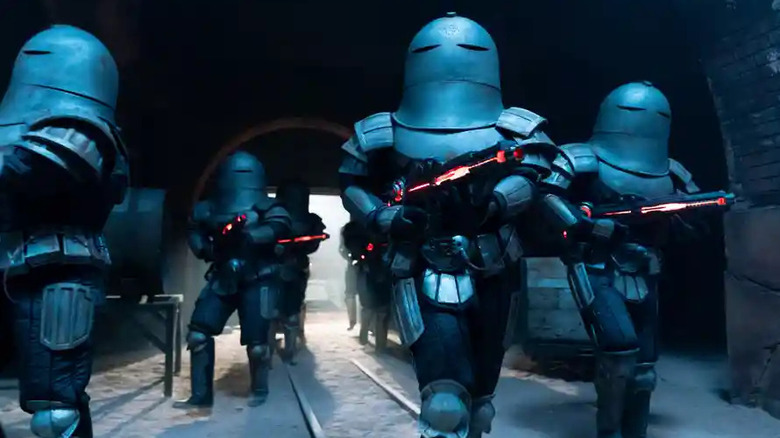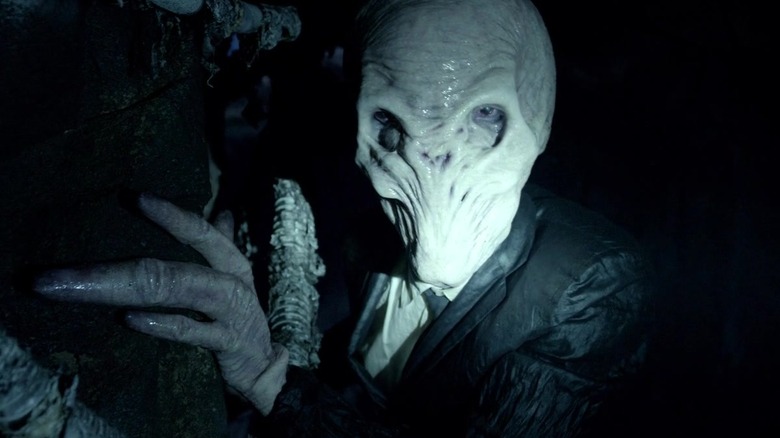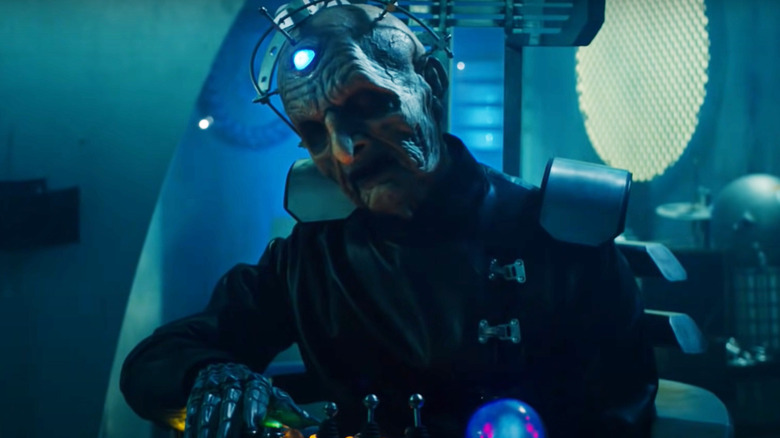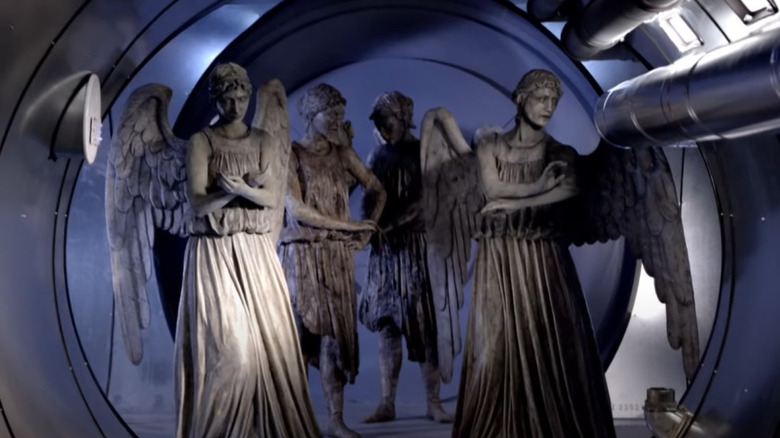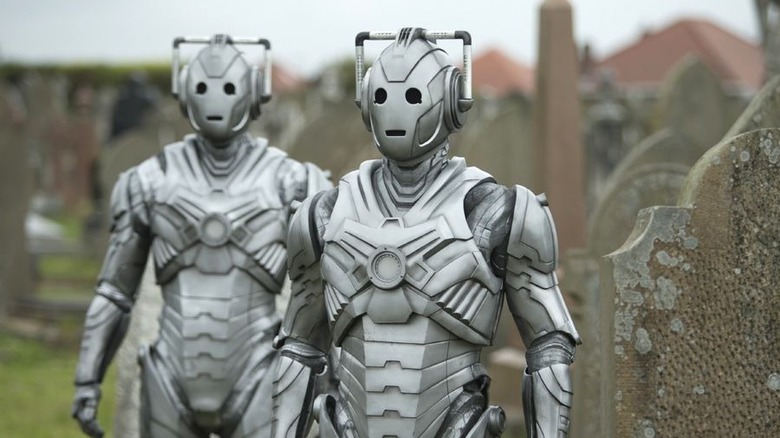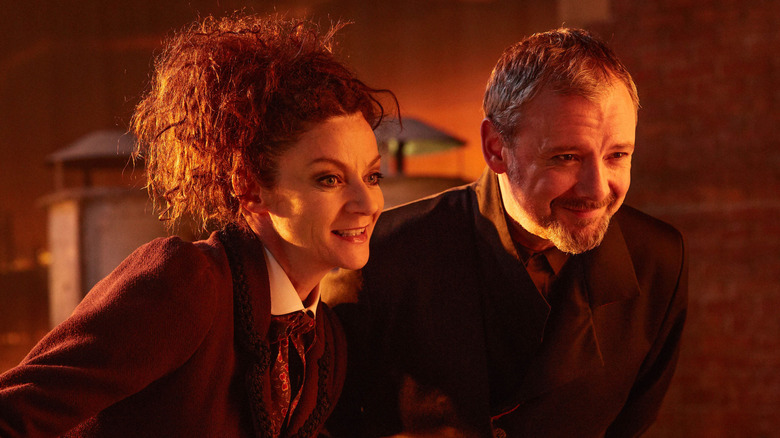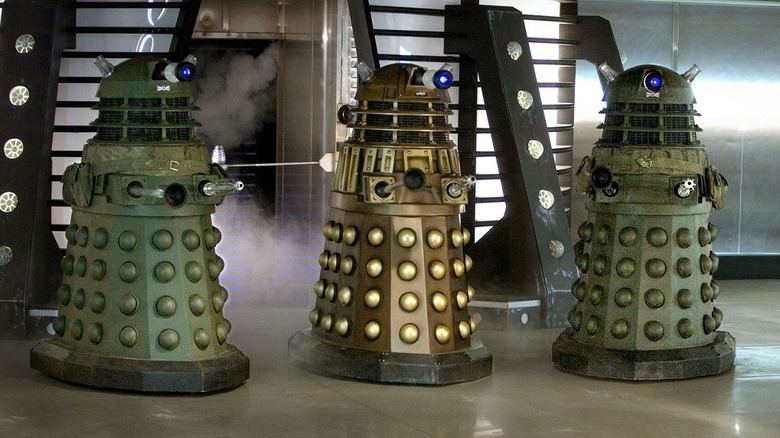The Greatest Villains In Doctor Who, Ranked
Few TV shows are as beloved as "Doctor Who." Having made its debut in 1963, this long-running franchise is an absolute icon of science fiction: Multiple generations have fallen in love with the Doctor's adventures across time and space, which have grown to truly epic proportions. One of the main reasons "Doctor Who" has lasted so long is its memorable characters — everyone has a favorite Doctor. But as much as fans love heroes like Amy Pond and Rose Tyler, they might love the series' bad guys even more.
"Doctor Who" features a plethora of formidable foes. Some are terrifying alien predators who suck the life out of the unfortunate beings who cross their path. Some are emotionless automatons whose only desire is conquest. Some are shapeshifting invaders who want to take the Earth for themselves. Some are even rival Time Lords, bent on universal domination. We're here to celebrate the most unforgettable evil-doers of the whole brutal bunch. These are the absolute greatest villains in all of "Doctor Who," ranked from worst to best.
20. The Autons
Fans of the "Doctor Who" revival will likely remember that its first villains are the Autons, a creepy alien species previously featured in the classic "Doctor Who" series. The Autons are a group of robotic lifeforms that resemble life-size mannequins. Though most of them appear to be made out of a sentient form of plastic, some are capable of adopting a relatively convincing human appearance. The Autons are even able to temporarily replace Mickey with their own plastic version, who acts as a spy.
Controlled by the disembodied hivemind known as the Nestene Consciousness, the Autons' motivations change over the course of the series. More often than not, however, they're depicted as alien invaders who wish to wipe out humanity and claim Earth for themselves. Apparently, pollutants have made Earth an ideal home for their species. Though various Doctors have interacted with them, the Autons remain fairly difficult to take seriously. But we have to admit, their blank, unemotional faces and stiff movements make them some of the creepiest looking antagonists the Doctor encounters in his adventures across time and space.
19. The Slitheen
The Slitheen are a great example of the kind of bizarre evil viewers have come to expect from "Doctor Who." Members of the alien race known as the Raxacoricofallapatorians, the Slitheen are a family of intergalactic criminals known for their large size and vaguely infantile features. Masters of impersonation, the Slitheen arrive on Earth after being exiled from their home planet, due to their criminal past. They immediately attempt to insert themselves into Earth's affairs by replacing key figures in world politics.Their only giveaways are a habit of blinking sideways and excessive flatulence.
The Slitheen come very close to triggering a nuclear war that could've wiped out all life on Earth. The fact that they instigate this so they can sell the planet's remains as a radioactive fuel source makes them even more despicable. They are, genuinely, one of the most dangerous alien species the Ninth Doctor ever faces, as well as some of the most instantly recognizable villains of the revamped "Doctor Who" series. But their goofiness makes it hard to take them seriously — chubby cheeks don't really scream "fearsome adversary." The Slitheen mean business, but this isn't enough to make them truly memorable.
18. The Krynoid
The Doctor faces many alien creatures that assimilate or consume everything in their path. One of the most notable is the Krynoid, a large, carnivorous lifeform with an insatiable appetite. Born from eggs, Krynoids start out as fairly small beings, roughly the size of a house plant. When a living creature draws close enough, the Krynoid extends a tendril to make contact, infects them, and slowly transforms them into another Krynoid. They proceed to travel through space, devour the living things they come across, then move on to the next planet, to repeat the process. They're not invulnerable, however: Krynoids are unable to brave the extreme temperatures of certain environments, and are especially susceptible to the harsh conditions of Antarctica.
The Krynoid is a classic alien; clear comparisons can be made between this "Doctor Who" creature and those of "The Thing," "The Blob," and the "Alien" franchise. Many fans hope that this invasive weed-like being will eventually pop up on the current series. Sadly, this has yet to happen. The Krynoid simply hasn't shown up often enough to earn a higher spot on this list.
17. The Zygons
One of a handful of classic "Doctor Who" villains who have been featured on the original series and the reboot, Zygons are a strange race of alien creatures known for their starfish-style heads, bright red skin, and the suckers that dot their bodies. They're also skilled mimics, capable of taking the physical form of any being. Eternally seeking to replace humanity as Earth's dominant species, the Zygons attempt to destroy mankind on more than a few occasions, but always see their efforts foiled by the Doctor in his various forms.
As the Zygons make their first appearance opposite the Fourth Doctor in 1975's "Terror of the Zygons," they're one of the older recurring alien races of "Doctor Who." They're also fairly popular among Whovians: According to the BBC, even David Tennant loves them. Compared to other villains like the Cybermen or the Daleks, however, the Zygons aren't that prominent. Their appearances are memorable, but they're simply not frequent enough to make a major splash.
16. The Sycorax
Though they only appear in one episode of the rebooted "Doctor Who," "The Christmas Invasion," the Sycorax establish themselves as a more-than-capable threat. A hostile, war-obsessed species, they arrive on Earth with the express intention of enslaving mankind. To carry out their goal, the Sycorax threaten to kill off every human with A positive blood unless half of humanity gives themselves up as slaves. Terrifyingly, they're able to control people with A positive blood through a unique alien device. Unfortunately for the Sycorax, the Doctor quickly figures out the limitations of their "blood control" technology and defeats their leader in single combat.
As a species that prides itself on cruelty, the Sycorax pose a serious physical and mental threat for the Doctor to overcome. Their unique appearance and ingenious tech also make them memorable. But they're far from the most iconic "Doctor Who" villains out there, especially given their singular spotlight. They're a challenge — but only briefly.
15. The Family of Blood
The Family of Blood are a band of telepathic aliens whose lifespan lasts only a few short months. Looking for a way to expand this time, the Family hunts the Doctor in the hopes of stealing his immortality. Though they disguise themselves as normal humans living in the English countryside circa 1913, they're easily distinguished by their unsettling mannerisms and penchant for referring to each other by their familial roles, rather than proper names.
The Family of Blood remain unique among "Doctor Who" adversaries for how far they push the Doctor. In fact, the Doctor is so terrified by the notion of fighting the Family, he turns himself into a human being and assumes the identity of a schoolteacher. After the Family tries to trigger the Doctor into returning to his Time Lord form — burning an entire village in the process — he exacts some of the most swift and brutal justice we've ever seen him take. In a sense, they get the immortality they want — but only because the Doctor imprisons them in various places around the universe for all eternity.
Few antagonists push the otherwise calm, cool, and collected Doctor so close to the edge. While the Family only appears in a single episode, they prove themselves capable of getting under the Doctor's skin in a truly potent way. They aren't prolific villains, but they are pretty memorable ones.
14. The Monks
The Monks don't rely on warfare or even explicit threats of violence to carry out their invasion of Earth. Rather, they use complex simulations to fool humans into thinking a threat from beyond the stars will soon destroy them, which only the benevolent Monks can stop. In truth, they're only interested in total global dominance. Uniquely, the Monks require 100% pure (if totally uninformed) consent from humanity: They can tell if even one individual person is consenting out of fear instead of genuine belief in the Monks as saviors, and won't hesitate to disintegrate them.
The Monks are undoubtedly some of the most interesting villains Peter Capaldi's Twelfth Doctor encounters during his time on the series. Their reliance on illusion and trickery sets them apart, as does their ending: When they realize their simulation is faltering, they opt to escape, rather than turn to outright warfare. They don't get much done, which excludes them from a higher spot on our list, but they do go about things in an intriguing way.
13. The Flood
One of the most legitimately terrifying episodes of "Doctor Who" is "The Water of Mars," which sees the Tenth Doctor arrive on a Martian colony plagued by a water-borne virus known as The Flood. This instantly infectious illness transforms its victims into zombie-like creatures who spread the virus far and wide. Eventually, the sentient Flood hopes to reach Earth.
Little is known about the Flood, aside from its hostile nature and desire to infect everything and everyone it encounters. Anyone infected with the disease seems to operate through a hivemind, evidenced by their orchestrated attacks and simultaneous movements. Victims also gain heightened physical strength and speed, as well as the ability to generate water from their mouths and limbs. They use this latter skill to spread the plague over great distances. Flood victims' physical appearances are also terrifying: The skin around their mouths becomes cracked and blackened, and their eyes turn an unnatural shade of blue.
Perhaps most terrifyingly, the Flood can sicken any being, from humans to Ice Warriors. This makes the potential scope of their destruction truly staggering — but that scope remains potential, as the Flood only appears in two episodes of "Doctor Who." They're also vulnerable to a variety of things, including freezing temperatures and electrocution. Still, the Flood stands out as a very troubling foe.
12. The Time Lords
It's easy to assume all Time Lords are as just and compassionate as the Doctor. While many fit this description, Time Lords are, in fact, predominantly depicted in antagonistic roles. Most often, they're at odds with the Doctor and his unorthodox methods of time travel. Time Lords are characterized by their fierce neutrality when it comes to events across time and space: They prefer to observe, rather than get involved. In their eyes, the Doctor unnecessarily jeopardizes the flow of time, and acts more out of emotion than rationality. The Time Lords attempt to punish the Doctor for these alleged affronts on several occasions, even condemning him to exile on Earth after his forced regeneration into the Third Doctor.
As if their tangled bureaucracy and strict conformity weren't enough, several Time Lords have proven themselves to be especially dangerous. The most notable example of this would be the Master, but other influential individuals also stand out, such as Rassilon. A power-hungry leader, he's willing to destroy the entire universe, rather than accept the potential end of the Time Lords.
11. Vashta Nerada
In "Silence in the Library" and "Forest of the Dead," the Doctor and his companion Donna journey to a library that spans an entire planet. This massive place has become infested with a microscopic species of carnivorous aliens known as the Vashta Nerada, which literally translates to "the shadows that melt the flesh."
Operating in large swarms, the Vashta Nerada hide in the shadows. They're capable of completely devouring their prey in an instant, leaving only a victim's bones and non-edible clothing behind. As if that weren't frightening enough, the Vashta Nerada are also capable of occupying a human's clothing: They use a corpse's spacesuit to pursue their quarry across the Library.
The Vashta Nerada reproduce by releasing their spores into wood, where they mature. No wonder the library, built from wood and full of tree-based paper, turns out to be capable of inculcating a gigantic swarm. But on their own, the Vashta Nerada are hardly a serious threat: What we see in this two-part episode is a particularly nasty case, but also a very rare one. This mutable nature lands them near the middle of our list.
10. Omega
A co-founder of the Time Lords' society and an integral member of their executive leadership, Omega is one of the closest things Gallifrey has to a living deity. Long ago, he attempted to use a device capable of harnessing the power of a star. This eventually made time travel possible, but it also collapsed into a black hole and apparently killed Omega in the process.
In reality, Omega survived the explosion. He became the sole occupant of an antimatter universe for thousands of years, and was eventually driven insane — but he retained the power to reshape the universe to his will. When multiple variations of the Doctor stumble upon him in "The Three Doctors," Omega reveals he's developed a vindictive hatred of Gallifrey and plans to permanently rid the universe of his former allies.
A villain who requires not one, not two, but three different iterations of the Doctor to be defeated is inherently impressive. Omega's tragic backstory makes him even more interesting: Sympathetic "Doctor Who" villains are hard to come by in the classic series. He's also more fleshed out than other power-hungry Gallifreyans like Rassilon and the Master. Omega might not cast the biggest shadow, but he definitely stands out.
9. The Great Intelligence
An antagonist whose appearances on "Doctor Who" date all the way back to 1967's "The Abominable Snowmen," the Great Intelligence is a mysterious creature in possession of a vast intellect. Even the Doctor admits he's not entirely sure what the Great Intelligence really is: It has no primary physical form, and relies on a variety of foot soldiers (robotic Yetis and subservient snowmen, for example) to carry out its nefarious plans for world domination.
The Great Intelligence's appearances have been sporadic, but in each one, it establishes itself as a dangerous threat. In the 2012 Christmas special "The Snowmen," the Great Intelligence nearly takes over Victorian London before being thwarted by the Eleventh Doctor. After recovering from this loss and nursing a bitter grudge against the Doctor, the Great Intelligence returns in "The Name of the Doctor." It plans to scatter itself across the Doctor's timeline and destroy him at every point in his life, effectively dooming the Doctor and the Great Intelligence. Clara manages to save the Doctor from this grim fate, perhaps wiping out the Great Intelligence's existence in the process. It remains to be seen whether versions of this character still exist somewhere in the Doctor's timeline, waiting for the proper moment to strike. This make the Great Intelligence a threat to be wary of, if not one at the top of the Doctor's list.
8. The Beast
The Beast is an enigmatic being who claims to be older than the universe and to have inspired the all-powerful horned figures of so many religions, including Satan. An immense, red-skinned creature, he was imprisoned in the planetary core of Krop Tor by the Disciples of Light. The only way for the Beast to escape his bonds is to destroy two jars of ancient origin, which would cause the planet to slip into a black hole. When human colonizers arrive on the planet, the Beast tries a different tack: He telepathically possesses their minds and turns their Ood servants against them. Ultimately, the Doctor destroys the jars holding the Beast in place, plunging the creature into the black hole to his apparent end.
The episodes in which the Beast features, "The Impossible Planet" and "The Satan Pit," are distinguished by their weighty subject matter and serious tone. The whole escapade ends with the Tenth Doctor questioning his own religious beliefs and wondering whether or not the Beast is actually Satan (he concludes it's a distinct possibility). Though this personification of evil only appears in this story, his sinister presentation and philosophical heft make him one of the most terrifying one-off villains in all of "Doctor Who."
7. The Sontarans
These blue-armored adversaries are characterized by an obsession with war and a ruthless desire for violent conquest. Described by the Tenth Doctor as some of the galaxy's most elite fighters, the Sontarans' militaristic society prides itself on prowess in battle and fearlessness in the face of death. Organized bands of Sontaran warriors have periodically arrived on Earth with the intention of conquering it, only to find themselves defeated by the Doctor.
Introduced all way back during Jon Pertwee's time as the Third Doctor, the Sontarans are one of the oldest and most frequently recurring species of aliens in "Doctor Who." This long history has firmly established them as one of the most brutal fighting forces in the entire universe, second only to the Daleks. While they're known for doing anything it takes in the name of victory, they're still capable of reason, rationality, and even emotion. This leads several Sontarans — most notably the Doctor's lovably crass companion, Strax — to align themselves with the Doctor on more than one occasion. Their ferocity makes them formidable, but it's this complexity that truly makes the Sontarans some of the franchise's most memorable villains.
6. The Silence
The Silence are a collection of towering aliens in black suits who have the unique ability to manipulate memory: Once a person has looked away from them, they forget the Silence exists. Originally a religious order known as the Priests of Silencio, a small splinter cell abandoned the sect after learning of a prophecy with the potential to destroy the universe. This prophecy involves the Eleventh Doctor asking a question — "Doctor who?" — which is actually a code word, meant to inform the Time Lords that it's safe to return to the universe and leave their pocket realm behind. Believing the return of the Time Lords will mean the renewal of the Time War, the Silence try to stop the Eleventh Doctor from ever fulfilling this prophecy by stalking him and his companions throughout their timeline.
Tall, pale, and expressionless, the Silence are frightening to behold. Moreover, they aren't fully explained until the latter half of Series 6, which makes their initial appearances all the more frightening. Not all members of the Silence are malevolent: Some adherents to the Church of the Silence aid the Doctor during the Siege of Trenzalore in "The Time of the Doctor." Still, their terrifying powers and look are potent enough to land them near the top of our list.
5. Davros
The creator of the Daleks, Davros is a mad scientist with megalomaniacal delusions of grandeur. Born into a brutal war between his people, the Kaleds, and their bitter enemies, the Thals, Davros was severely wounded when a Thal shell destroyed his lab. Looking to turn the war in the Kaleds' favor, Davros perfected his version of the ultimate killing machine: the Daleks. But the Kaleds began to believe that Davros' creations were too dangerous, and tried to shut down the project. Thus, Davros orchestrated the extinction of his own race, leaving behind only a select few still loyal to him, to ensure his experiments could continue unimpeded.
Davros is a bloody-minded fascist whose primary desire is victory through conquest, with an eye towards eventually seizing control over the entire universe. As morally repulsive as his creations, Davros wreaks havoc via war, indiscriminate violence, and mass genocide. At one point, he even plans to destroy all non-Dalek life in the universe through the use of his Reality Bomb. Creating the Doctor's worst enemies would've been reason enough to rank him highly on this list, but his completely amoral stance on non-Dalek life makes Davros especially reprehensible.
4. The Weeping Angels
Far and away the most purely terrifying villains in "Doctor Who" history, the Weeping Angels are also one of the revival's strongest additions to the canon. This alien species is only able to move when they're not being observed by other living creatures. As soon as someone looks at them, they're locked into place and turn to literal stone. This might seem like a major weakness, but the Angels are also capable of unbelievably fast movement — they can travel several feet forward in the blink of an eye. This makes them the ideal covert assassins. However, their greatest strength is also their biggest flaw when it comes to interspecies interaction: If one Angel looks upon another, they are locked into position permanently.
The Angels "murder" their victims by transporting them back in time: Said victims live out their lives in another era, in lieu of their present. Through this unique method, the Angels absorb their victims' time energy, which is their primary source of sustenance. Since their debut in "Blink," they've become one of the Doctor's most frequently recurring enemies, battling everyone from the Tenth to the Thirteenth Doctor. And no wonder — their design, powers, and origin story are among the most unique in the franchise's history.
3. Cybermen
Like the Daleks, their chief rivals, the Cybermen are featured in numerous episodes of the classic series and the revival. Their backstory varies, depending on the episode in question. In the original series, the Cybermen come from Mondas, Earth's ancient twin planet. Its inhospitable conditions force the population to artificially recreate themselves as Cybermen in order to survive. In the revival series, they come from a parallel version of Earth, where a mad scientist obsessed with immortality converted humans into Cybermen. This transformation guarantees a longer lifespan, but it robs humans of their emotions and individual thought.
Regardless of origin story, the Cybermen are consistently depicted as cold killing machines whose primary objective is to transform everyone they stumble across into Cybermen — a very painful process known as cyber-conversion. Every so often, they reappear in "Doctor Who" with deadly modifications and upgrades to their armor, making them even harder to defeat. Known for their signature phrase — the monotonously delivered "Delete, delete" — Cybermen are some of the most effective killing machines in the universe. Practically every version of the Doctor has faced them at some point, and for good reason: They're as frightening as they are intriguing.
2. The Master
No single character has ever been more of a threat to the Doctor than the Master, whose appearances date back to 1971's "Terror of the Autons." A fellow Time Lord and the Doctor's childhood best friend, the Master is motivated solely by his desire to dominate others, and is one of the few characters capable of outsmarting the Doctor. Like his adversary, the Master's many regenerations have resulted in drastically different portrayals, ranging from Roger Delgado's smugly sophisticated take to the unstable and overtly sociopathic version of the character played by John Simm. But no matter the actor, the Master possesses an unbelievably keen mind and a penchant for cruelty.
Due to the Master's close relationship with the Doctor, he's been depicted as both an estranged friend and an archenemy. He can get inside our hero's head in a totally unique way, which makes him all the more threatening, as well as interesting. Fans always know they're in for a treat whenever the Master appears on "Doctor Who," no matter the era. That's the sign of a villain who isn't just great, but superb.
1. The Daleks
Who else but the Daleks could be number one on this list? First appearing opposite the First Doctor in 1963's "The Daleks," they are the oldest villain in the series, and have opposed every single version of the Doctor. Created by Davros to be the deadliest fighting force in the universe, the Daleks are the mutated remnants of the Kaleds, an alien race with a fierce belief in racial "purity." The Daleks have been genetically modified over the course of centuries of nuclear war and chemical fallout, and have "weaknesses" like emotion, empathy, and mercy removed. As a result, they're shriveled creatures no larger than squids. But when they're placed inside their armored tank-like shells and equipped with electrolasers, they become the universe's most elite warriors: A single Dalek is capable of destroying entire military squadrons.
Known for their heightened aggression, shrill voices, and their signature catchphrase — "Exterminate!" — the Daleks stand alone as the Doctor's the most fearsome recurring foes. They're also incredibly popular among fans and have become icons of science fiction as a whole. Their pitiless approach to warfare, desire to rid the universe of every "lesser" species, and eye-catching design is nothing short of legendary at this point, and will likely remain so for decades to come. Simply put, the Daleks are as key to the success of "Doctor Who" as the Doctor, and that's why they take the top spot on this list.
